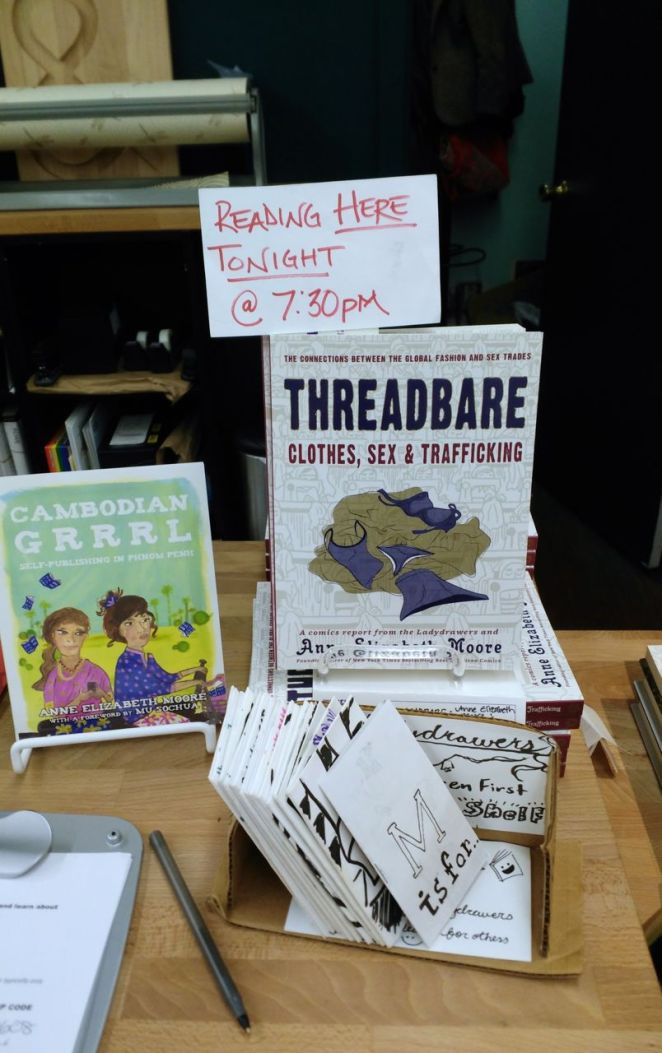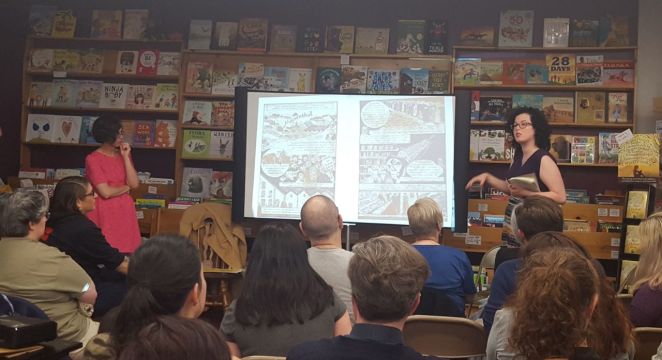We’re off to the Figge Art Museum in Davenport, Iowa at the behest of St. Ambrose University this week to install an original window mural. (In-progress draft below by Melissa Mendes.) The images, by Mendes and Sheika Lugtu, will be accompanied by oral histories from local Quad Cities residents regarding two major aspects of Davenport’s participation in the struggle for civil rights, and public commemoration of that past: the fight for equal marriage and black history.

The interviews, conducted by Chris Reno and Tessa Pozzi of SAU’s Catich Gallery and edited by Anne Elizabeth Moore, focused on how folks defined and experienced civil rights, and what visible reminders of past struggles they had located in their community. Questions were inspired by articles on the queerest cities in America; this amazing wedding; and the city’s destruction of sites of black history, as well as this powerpoint presentation on civil rights in Iowa and this video (from SAU!) on a planned civil rights walking tour.
Our interviewees were very generous with their time and our questions, and gave some beautiful insight into the Davenport area, and the absolute importance of keeping a constantly updated notion of civil rights at the center of public conversation. You’ll see more in the mural when we finish it April 7—a part of SAU’s Fair Play conference, hope you can come—but some of the quotes we’re most inspired by are below.
PASTOR RICH HENDRICKS
“I didn’t come out until I was 40. I grew up here—the community has become more diverse. I left here when I went to college. I don’t remember any African-American kids in my elementary school. …
“I grew up a product of a poor education. We had no sex ed when I was growing up. I didn’t realize that gay was an option. … My only recollection of a comment when I was younger was, I can remember my folks or their friends saying something about ‘those people down by the levy.’ The way they said it, you could tell it was dirty. I didn’t know what they were talking about, but I could tell it was unacceptable. That was, you know, the cruising area.”
VICKI PHIPPS
“I have the best job in the whole world. In my own work, I address power relationships. In one of the projects I’m working on, I’m working with a biracial student on this notion of microaggressions. In general, why does a person of difference have to educate everyone else? Can art and design help further that?”
“I’m the last member of my family that could move back to the reservation. But people don’t meet me and go ‘Oh, Native American!’ Whereas they do see [my student] and go, ‘You’re black.’ So we both have a long list of things that follow us that you can’t leave behind. …”
KAYLA BUSHEY
“I feel like civil rights really mean equality. Equality for every type of person. … I feel like that really gets smudged along the way. It’s weird to say that I am this, or I am that, but according to standardized tests, I am half Caucasian, half African-American. My dad’s side is the white side and my mom’s side is the black side. It’s strange because here in school, either you’re a part of the Black Student Union, or you are the populous of the white student body. I feel like I try to tread that line—honestly, trying to get that privilege on both sides. Or wherever I can. I’ll go over to my dad’s side of the family. He’s a general in the military and he wants rights for people, but only if people have earned their rights. It’s hard to be like, well you were born with rights. Then I go to my mom’s side of the family, and she’s like, we need women’s rights, we need LGBTQ rights. I even have friends who haven’t experienced that push and pull from both sides. … I think when people pick and choose what kind of rights people should and shouldn’t get, they’re not really enforcing civil rights.”
ANONYMOUS
“Right or wrong, the assumption has been that gay, lesbian, transgender, and/or bisexual people are outside of the realm of—this is gonna sound bad—us good black folks. So then those of us who fit any of those [categories] are on the fringes. I remember studying sociology and talking about marginal people. So if you were white and gay and male in the 1960s, then you were kinda marginalized. But you still had your whiteness and your maleness, but if you’re black and lesbian, then you got nothin’.”
 A seven-year, three-continent project has finally come to a close, and we at Ladydrawers HQ just wanted to say thanks! With your support we put out—and survived touring with—a massively complex work of comics journalism that tracks the pernicious influence of the garment industry across international borders and into the streets and bedrooms of women around the world. (Standout sex-workers rights site Tits & Sass named it to a list of the year’s Best Investigative Reporting on Sex Work, and says it “connects all the threads of industrial and imperialist abuses, and presents a seamless and ugly portrait of an imperialism that never died, only changing to better fit the times—an imperialism which is still at the heart of so many exploitations and abuses worldwide.” Read the whole
A seven-year, three-continent project has finally come to a close, and we at Ladydrawers HQ just wanted to say thanks! With your support we put out—and survived touring with—a massively complex work of comics journalism that tracks the pernicious influence of the garment industry across international borders and into the streets and bedrooms of women around the world. (Standout sex-workers rights site Tits & Sass named it to a list of the year’s Best Investigative Reporting on Sex Work, and says it “connects all the threads of industrial and imperialist abuses, and presents a seamless and ugly portrait of an imperialism that never died, only changing to better fit the times—an imperialism which is still at the heart of so many exploitations and abuses worldwide.” Read the whole 
 Did you know Anne Elizabeth Moore and Esther Pearl Watson collaborated on the very first Ladydrawers strip together way back in 2010? Well it was collected into the latest edition of the rad, international anthology Kuti Kuti—the feminist issue, with a cover drawn by our superbestie Emmi Valve—and you can
Did you know Anne Elizabeth Moore and Esther Pearl Watson collaborated on the very first Ladydrawers strip together way back in 2010? Well it was collected into the latest edition of the rad, international anthology Kuti Kuti—the feminist issue, with a cover drawn by our superbestie Emmi Valve—and you can 




